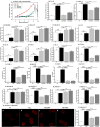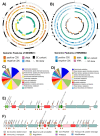Potential probiotic Lactiplantibacillus plantarum strains alleviate TNF-α by regulating ADAM17 protein and ameliorate gut integrity through tight junction protein expression in in vitro model
- PMID: 39468700
- PMCID: PMC11514838
- DOI: 10.1186/s12964-024-01900-7
Potential probiotic Lactiplantibacillus plantarum strains alleviate TNF-α by regulating ADAM17 protein and ameliorate gut integrity through tight junction protein expression in in vitro model
Abstract
Background: Lactiplantibacillus species are extensively studied for their ability to regulate host immune responses and functional therapeutic potentials. Nevertheless, there is a lack of understanding on the mechanisms of interactions with the hosts during immunoregulatory activities.
Methods: Two Lactiplantibacillus plantarum strains MKMB01 and MKMB02 were tested for probiotic potential following Indian Council of Medical Research (ICMR) guidelines. Human colorectal adenocarcinoma cells such as HT-29, caco-2, and human monocytic cell THP-1 were also used to study the potential of MKMB01 and MKMB02 in regulating the host immune response when challenged with enteric pathogen Salmonella enterica typhimurium. Cells were pre-treated with MKMB01 and MKMB02 for 4 h and then stimulated with Salmonella. qRT-PCR and ELISA were used to analyze the genes and protein expression. Confocal microscopy and field emission scanning electron microscopy (FESEM) were used to visualize the effects. An Agilent Seahorse XF analyzer was used to determine real-time mitochondrial functioning.
Results: Both probiotic strains could defend against Salmonella by maintaining gut integrity via expressing tight junction proteins (TJPs), MUC-2, and toll-like receptors (TLRs) negative regulators such as single Ig IL-1-related receptor (SIGIRR), toll-interacting protein (Tollip), interleukin-1 receptor-associated kinase (IRAK)-M, A20, and anti-inflammatory transforming growth factor-β and interleukin-10. Both strains also downregulated the expression of pro-inflammatory cytokines/chemokines interleukin-1β, monocyte chemoattractant protein (MCP)-1, tumor necrosis factor-alpha (TNF-α), interleukin 6, and nitric oxide (NO). Moreover, TNF-α sheddase protein, a disintegrin and metalloproteinase domain 17 (ADAM17), and its regulator iRhom2 were downregulated by both strains. Moreover, the bacteria also ameliorated Salmonella-induced mitochondrial dysfunction by restoring bioenergetic profiles, such as non-mitochondrial respiration, spare respiratory capacity (SRC), basal respiration, adenosine triphosphate (ATP) production, and maximal respiration.
Conclusions: MKMB01 and MKMB02 can reduce pathogen-induced gut-associated disorders and therefore should be further explored for their probiotic potential.
Keywords: ADAM17 and iRhom2; Anti-inflammatory; Gut integrity; Immunomodulatory; Oxidative stress; Probiotics.
© 2024. The Author(s).
Conflict of interest statement
The authors declare no competing interests.
Figures




Similar articles
-
Adhesive and chemokine stimulatory properties of potentially probiotic Lactobacillus strains.J Food Prot. 2007 Jan;70(1):125-34. doi: 10.4315/0362-028x-70.1.125. J Food Prot. 2007. PMID: 17265871
-
Beneficial effect of immunobiotic strains on attenuation of Salmonella induced inflammatory response in human intestinal epithelial cells.PLoS One. 2020 Mar 9;15(3):e0229647. doi: 10.1371/journal.pone.0229647. eCollection 2020. PLoS One. 2020. PMID: 32150574 Free PMC article.
-
Lactobacilli stimulate the innate immune response and modulate the TLR expression of HT29 intestinal epithelial cells in vitro.Int J Food Microbiol. 2009 Jul 31;133(1-2):86-93. doi: 10.1016/j.ijfoodmicro.2009.05.013. Epub 2009 May 15. Int J Food Microbiol. 2009. PMID: 19523707
-
Immunomodulatory Activity on Human Macrophages by Cell-Free Supernatants to Explore the Probiotic and Postbiotic Potential of Lactiplantibacillus plantarum Strains of Plant Origin.Probiotics Antimicrob Proteins. 2024 Jun;16(3):911-926. doi: 10.1007/s12602-023-10084-4. Epub 2023 May 18. Probiotics Antimicrob Proteins. 2024. PMID: 37202651 Free PMC article.
-
Bioprospecting Antimicrobials from Lactiplantibacillus plantarum: Key Factors Underlying Its Probiotic Action.Int J Mol Sci. 2021 Nov 8;22(21):12076. doi: 10.3390/ijms222112076. Int J Mol Sci. 2021. PMID: 34769500 Free PMC article. Review.
Cited by
-
Evaluation of the Safety and Impact of Heat-Treated Lactiplantibacillus plantarum KM2 Fermentation on Gut Microbiome Architecture.J Microbiol Biotechnol. 2024 Dec 27;35:e2411069. doi: 10.4014/jmb.2411.11069. J Microbiol Biotechnol. 2024. PMID: 39757420 Free PMC article. Clinical Trial.
-
Engineered Probiotic-Based Biomaterials for Inflammatory Bowel Disease Treatment.Theranostics. 2025 Feb 18;15(8):3289-3315. doi: 10.7150/thno.103983. eCollection 2025. Theranostics. 2025. PMID: 40093907 Free PMC article. Review.
References
-
- Chanana V, Majumdar S, Rishi P. Tumour necrosis factor α mediated apoptosis in murine macrophages by Salmonella enterica Serovar Typhi under oxidative stress. Volume 47. FEMS Immunology & Medical Microbiology; 2006. pp. 278–86. 2. - PubMed
MeSH terms
Substances
Grants and funding
LinkOut - more resources
Full Text Sources
Miscellaneous

